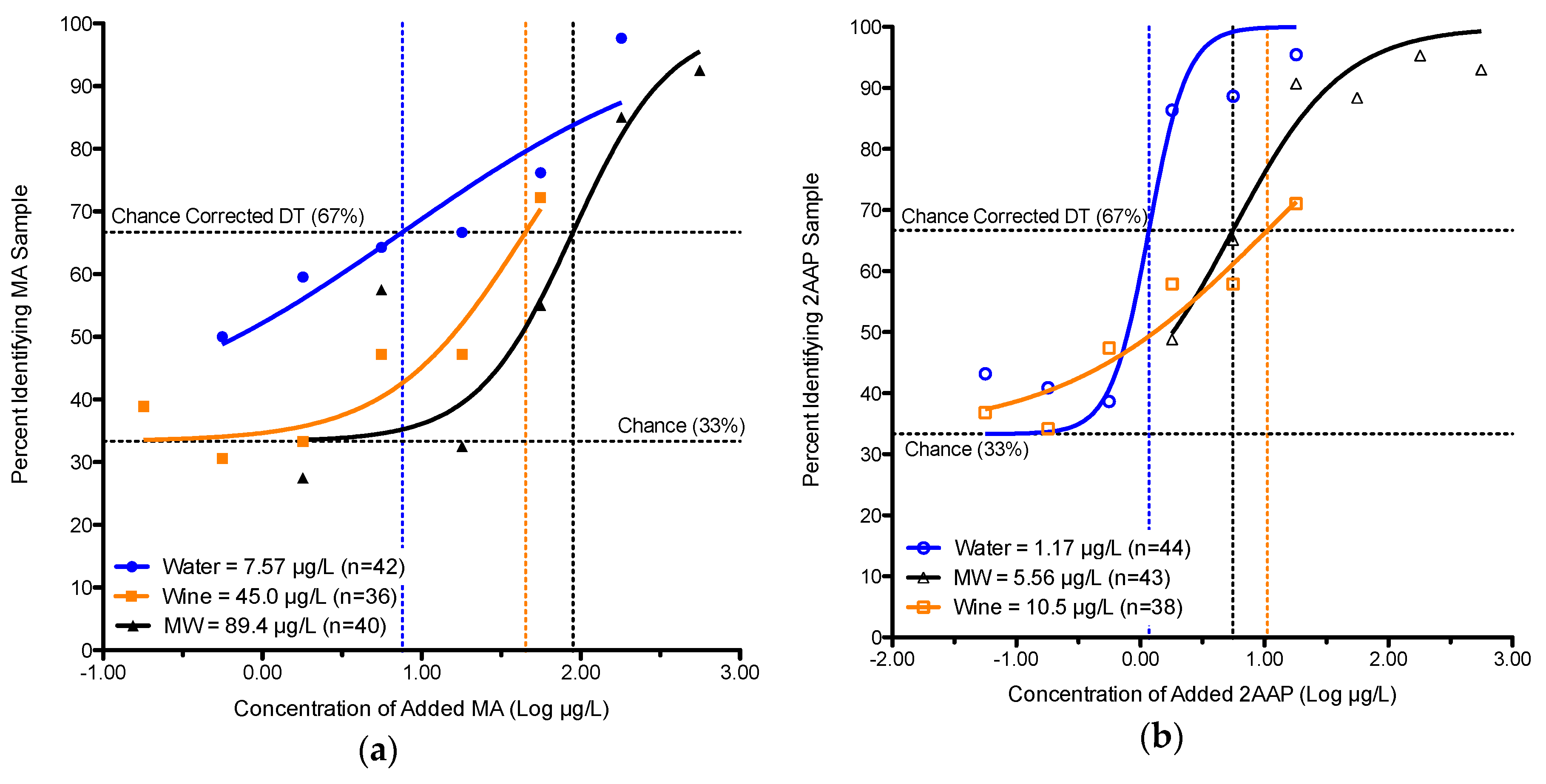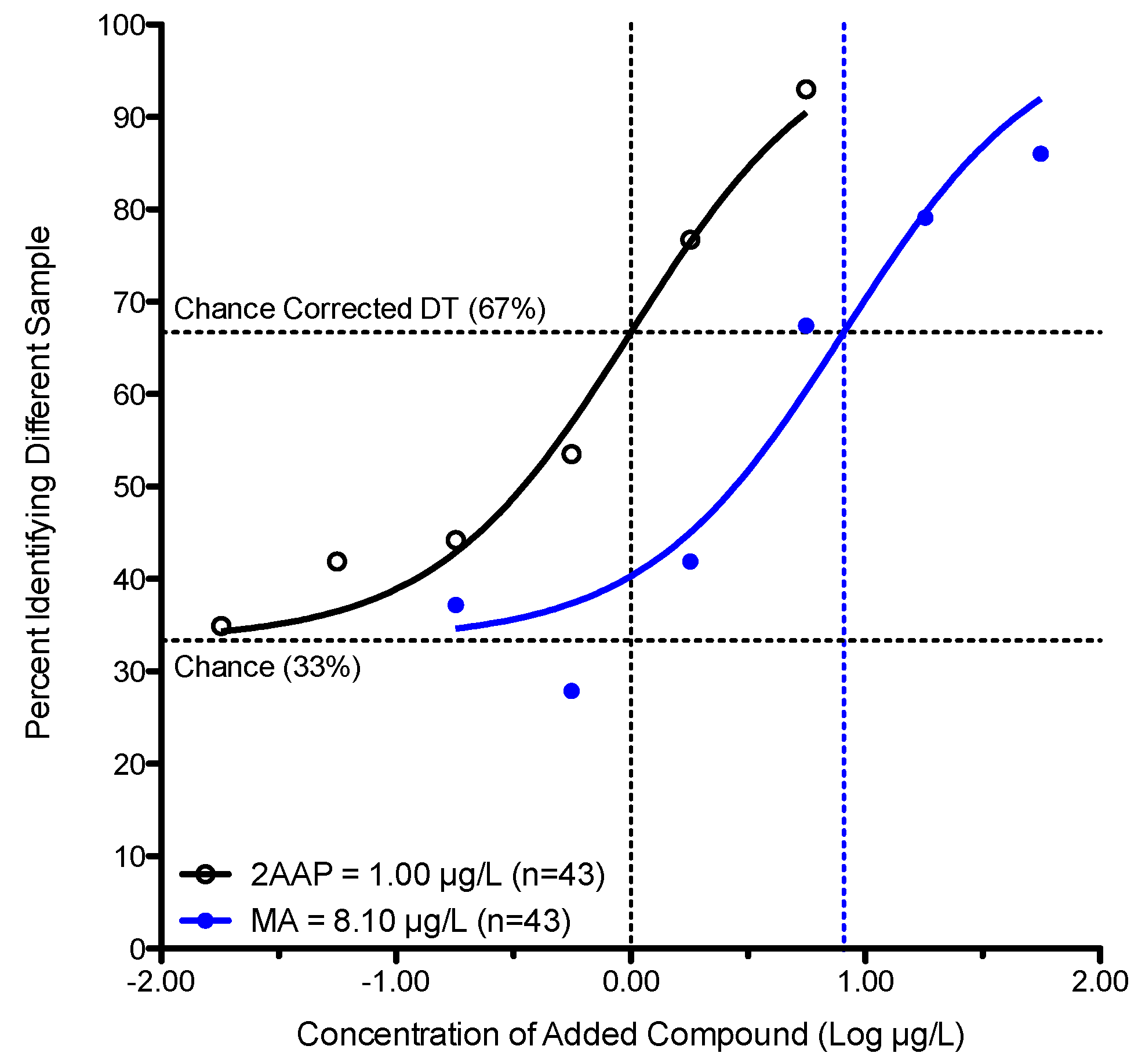Effects of Matrix Composition on Detection Threshold Estimates for Methyl Anthranilate and 2-Aminoacetophenone
Abstract
:1. Introduction
2. Materials and Methods
2.1. Overview
2.2. Stimuli
2.3. Concentration Ranges
2.4. Sample Preparation
2.5. Data Collection and Analysis
2.5.1. Sensory Methodology
2.5.2. Data Analysis
3. Results
3.1. Matrix Effects on Detection Thresholds
3.2. Investigating Reported Differences in Detection Threshold between Methyl Anthranilate and 2-Aminoacetophenone
4. Discussion
4.1. Significance and Innovation
4.2. Study Limitations and Future Directions
5. Conclusions
Supplementary Materials
Acknowledgments
Author Contributions
Conflicts of Interest
Abbreviations
| MA | methyl anthranilate |
| 2AAP | 2-aminoacetophenone |
| OAV | odor activity value |
| DT | detection threshold |
| CT | confidence interval |
References
- Fan, W.; Tsai, I.; Qian, M. Analysis of 2-aminoacetophenone by direct-immersion solid-phase microextraction and gas chromatography-mass spectrometry and its sensory impact in Chardonnay and Pinot gris wines. J. Food Chem. 2007, 105, 1144–1150. [Google Scholar] [CrossRef]
- Hoenicke, K.; Simat, T.J.; Steinhart, H.; Christoph, N.; Gebner, M.; Kohler, H.J. Untypical aging off-flavor in wine: Formation of 2-aminoacetophenone and evaluation of its influencing factors. Anal. Chim. Acta 2002, 458, 2948–2953. [Google Scholar] [CrossRef]
- Nelson, R.R.; Acree, T.E.; Lee, C.Y.; Butts, R.M. Methyl Anthranilate as an aroma constituent of American wine. J. Food Sci. 1977, 42, 57–59. [Google Scholar] [CrossRef]
- Czerny, M.; Christlbauer, M.; Christlbauer, M.; Fischer, A.; Granvogl, M.; Hammer, M.; Hartl, C.; Hernandez, N.M.; Schieberle, P. Re-investigation on odour thresholds of key food aroma compounds and development of an aroma language based on odour qualities of defined aqueous odorant solutions. Eur. Food Res. Technol. 2008, 228, 265–273. [Google Scholar] [CrossRef]
- Iland, P.; Bruer, N.; Edwards, G.; Weeks, S.; Wilkes, E. Chemical Analysis of Grapes and Wine: Techniques and Concepts; Patrick Iland Wine Promotions Pty. Ltd.: Campbelltown, South Australia, 2004; pp. 30–43. [Google Scholar]
- Goodstein, E.S.; Bohlscheid, J.C.; Evans, M.; Ross, C. Perception of flavor finish in model white wine: A time-intensity study. Food Qual. Preference 2014, 36, 50–60. [Google Scholar] [CrossRef]
- Lawless, H.T.; Heymann, H. Sensory Evaluation of Food: Principles and Practices, 2nd ed.; Springer Science + Business Media, LLC: New York, NY, USA, 2010. [Google Scholar]
- Lawless, H. A simple alternative analysis for threshold data determined by ascending forced-choice methods of limits. J. Sens. Stud. 2009, 25, 332–346. [Google Scholar] [CrossRef]
- ASTM. E679-04 Standard Practice for Determination of Odor and Taste Thresholds by a Forced-Choice Ascending Concentration Series Method of Limits; ASTM International: West Conshohocken, PA, USA, 2011. [Google Scholar]
- Hoenicke, K.; Borchert, O.; Gruning, K.; Simat, T. Untypical aging off-flavor in wine: synthesis of potential degradation compounds of indole-3-acetic acid and kynurenine and their evaluation as precursors of 2-aminoacetophenone. J. Agric. Food Chem. 2002, 50, 4303–4309. [Google Scholar] [CrossRef] [PubMed]
- Martineau, B.; Acree, T.; Henick-Kling, T. Effect of Wine Type on the Detection Threshold for Diacetyl. Food Res. Int. 1995, 28, 139–143. [Google Scholar] [CrossRef]
- Leonardos, G.; Kendall, D.; Barnard, N. Odor Threshold Determinations of 53 Odorant Chemicals. J. Air Pollut. Control Assoc. 1969, 19, 91–95. [Google Scholar] [CrossRef]
- Amoore, J.E.; Hautala, E. Odor as an aid to chemical safety: Odor thresholds compared with threshold limit values and volatilities for 214 industrial chemicals in air and water dilution. J. Appl. Toxicol. 1983, 3, 272–290. [Google Scholar] [CrossRef] [PubMed]
- Conner, J.M.; Birkmyre, L.; Paterson, A.; Piggott, J.R. Headspace Concentrations of Ethyl Esters at Different Alcoholic Strengths. J. Sci. Food Agric. 1998, 77, 121–126. [Google Scholar] [CrossRef]
- Berre, E.L.; Atanasova, B.; Langlois, D.; Etievant, P.; Thomas-Danguin, T. Impact of ethanol on the perception of wine odorant mixtures. Food Qual. Preference 2007, 18, 901–908. [Google Scholar] [CrossRef]
- Ruth, S.M.; Grossmann, I.; Geary, M.; Delahunty, C. Interactions between Artificial Saliva and 20 Aroma Compounds in Water and Oil Model Systems. J. Agric. Food Chem. 2001, 49, 2409–2413. [Google Scholar] [CrossRef] [PubMed]
- Genovese, A.; Piombino, P.; Gambuti, A.; Moio, L. Simulation of retronasal aroma of white and red wine in a model mouth system. Investigating the influence of saliva on volatile compound concentrations. J. Food Chem. 2009, 114, 100–107. [Google Scholar] [CrossRef]


| Water | Model Wine | Wine | |
|---|---|---|---|
| Experiment 1 | MA | MA | |
| Experiment 2 | MA vs. 2AAP | ||
| Experiment 3 | 2AAP | ||
| Experiment 4 | MA | MA | |
| Experiment 5 | 2AAP | 2AAP |
| Water | Wine | Model Wine | |||||||
|---|---|---|---|---|---|---|---|---|---|
| DT | 95% CI | n * | DT | 95% CI | n | DT | 95% CI | n | |
| Experiment 1 | 7.51 | 3.1–17.9 | 38 | 45.0 | 21.2–95.5 | 36 | - | - | - |
| Experiment 2 | 8.10 | 3.82–17.2 | 43 | - | - | - | - | - | - |
| Experiment 4 | 7.57 | 2.30–25.0 | 42 | - | - | - | 89.4 | 28.2–283 | 40 |
| Water | Wine | Model Wine | |||||||
|---|---|---|---|---|---|---|---|---|---|
| DT | 95% CI | n * | DT | 95% CI | n | DT | 95% CI | n | |
| Experiment 2 | 1.00 | 0.685–1.47 | 43 | - | - | - | - | ||
| Experiment 3 | - | - | - | 10.5 | 3.79–29.3 | 38 | - | - | |
| Experiment 5 | 1.17 | 0.614–2.24 | 44 | - | - | 5.56 | 2.94–10.5 | 43 | |
| Water 1 | Wine | Model Wine | ||||
|---|---|---|---|---|---|---|
| DT | 95% CI | DT | 95% CI | DT | 95% CI | |
| MA | 7.73 | - | 45.0 | 21.2–95.5 | 89.4 | 28.2–283 |
| 2AAP | 1.09 | - | 10.5 | 3.79–29.3 | 5.56 | 2.94–10.5 |
© 2016 by the authors; licensee MDPI, Basel, Switzerland. This article is an open access article distributed under the terms and conditions of the Creative Commons Attribution (CC-BY) license (http://creativecommons.org/licenses/by/4.0/).
Share and Cite
Perry, D.M.; Hayes, J.E. Effects of Matrix Composition on Detection Threshold Estimates for Methyl Anthranilate and 2-Aminoacetophenone. Foods 2016, 5, 35. https://doi.org/10.3390/foods5020035
Perry DM, Hayes JE. Effects of Matrix Composition on Detection Threshold Estimates for Methyl Anthranilate and 2-Aminoacetophenone. Foods. 2016; 5(2):35. https://doi.org/10.3390/foods5020035
Chicago/Turabian StylePerry, Demetra M., and John E. Hayes. 2016. "Effects of Matrix Composition on Detection Threshold Estimates for Methyl Anthranilate and 2-Aminoacetophenone" Foods 5, no. 2: 35. https://doi.org/10.3390/foods5020035
APA StylePerry, D. M., & Hayes, J. E. (2016). Effects of Matrix Composition on Detection Threshold Estimates for Methyl Anthranilate and 2-Aminoacetophenone. Foods, 5(2), 35. https://doi.org/10.3390/foods5020035






